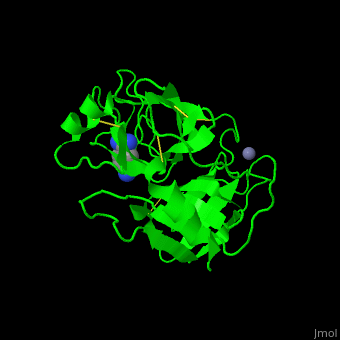Function
Kallikrein (KLK) is a serine protease. Plasma KLK releases the peptides bradykinin and kallidin from kininogen and plasmin from plasminogen. Tissue KLK participates in the regulation of blood pressure by activation of bradykinin[1].
- KLK1 releases the vasoactive peptide Lys-bradikinin from kininogen.
- KLK2 is prostate-specific.
- KLK4 cleaves extracellular matrix proteins.
- KLK5 and KLK7 regulate cell shedding.
- KLK6 regulates immune cells survival.
- KLK8 is involved inproteolytic cascade in the skin.
- plasma KLK cleaves Arg and Lys in kininogen to release bradykinin.
- Tissue KLK is expressed throughout the body.
Disease
Activation of the plasma KLK pathway may contribute to diabetic macular edema[2]. KLK6 is implicated in carcinogenesis, Alzheimer and Parkinson diseases[3]. KLK8 processes papilloma virus fascilitating their entry to host cells[4].
.
Structural highlights
KLK being a serine protease contains the [5]. Water molecules shown as red spheres.
3D Structures of kallikrein
Kallikrein 3D structures

